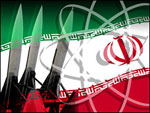 New York Times: Is Iran finally ready to talk? Iran’s new president, Hassan Rouhani, has said he’s ready for nuclear negotiations. And in recent weeks, the Iranian government has repeatedly expressed its desire to reach a deal on its uranium enrichment program.
New York Times: Is Iran finally ready to talk? Iran’s new president, Hassan Rouhani, has said he’s ready for nuclear negotiations. And in recent weeks, the Iranian government has repeatedly expressed its desire to reach a deal on its uranium enrichment program.
The New York Times
By AMOS YADLIN and AVNER GOLOV
 TEL AVIV — IS Iran finally ready to talk? Iran’s new president, Hassan Rouhani, has said he’s ready for nuclear negotiations. And in recent weeks, the Iranian government has repeatedly expressed its desire to reach a deal on its uranium enrichment program.
TEL AVIV — IS Iran finally ready to talk? Iran’s new president, Hassan Rouhani, has said he’s ready for nuclear negotiations. And in recent weeks, the Iranian government has repeatedly expressed its desire to reach a deal on its uranium enrichment program.
A few days after Mr. Rouhani’s election victory, Russia’s foreign minister, Sergey V. Lavrov, stated that Iran was prepared to limit its enrichment to a level below 20 percent, which is the main goal of a future agreement between the West and Iran. And last month, Iraq’s prime minister, Nuri Kamal al-Maliki, reportedly told the White House that Iran wanted to begin direct nuclear negotiations with the United States.
But it would be dangerous to think that Iran’s proposal for negotiations alone would pave the way for a deal. What matters is not the talks but the outcome.
Whoever negotiates with Iran must acknowledge that the enrichment of uranium from a low level (3.5 percent to 19.75 percent) to weapons-grade level (90 percent) is only one of three dimensions of Iran’s nuclear strategy. A second dimension is Iran’s progress toward a quick “breakout capability” through the stockpiling of large quantities of low-enriched uranium that could be further enriched rapidly to provide weapons-grade fuel. Third, Iran also appears to be pursuing a parallel track to a nuclear capability through the production of plutonium.
If there is going to be a nuclear deal with Iran, all three parts of its strategy must be addressed.
In the past year, Iran has installed thousands of centrifuges, including more than 1,000 advanced ones. A report by the International Atomic Energy Agency states that Iran already has enough low-enriched uranium to produce several nuclear bombs if it chooses to further enrich the fuel. Iran has deliberately refrained from crossing what is perceived as Israel’s red line: 240 kilograms (about 530 pounds) of uranium enriched to a level of 19.75 percent.
Nonetheless, Western experts like Graham T. Allison Jr. and Olli Heinonen estimate that if Iran decided to develop a bomb today, it could do so within three to five months. That is assumed to be sufficient lead time for the West to detect and respond to an Iranian decision.
But a recent report from the Institute for Science and International Security estimates that at the current pace of installation, Iran could reduce its breakout time to just one month by the end of this year. The report also estimates that at that pace, by mid-2014 Iran could reduce the breakout time to less than two weeks.
Any agreement must ensure that an Iranian breakout is detected quickly enough to allow for a Western response — meaning that the international community must be able to uncover any concealed facilities and activities for the production of fissile material.
A solution will also have to address the potential for a plutonium bomb. In May, Iran announced that the heavy-water reactor in Arak would become operational early next year. Some American and European officials claim that Iran could produce weapons-grade plutonium next summer. These two announcements indicate that Iran is making progress on this alternative track. So far, the West has not paid much attention to the potential for a plutonium-fueled weapon. Now it must do so.
A functioning nuclear reactor in Arak could eventually allow Iran to produce sufficient quantities of plutonium for nuclear bombs. Although Iran would need to build a reprocessing facility to separate the plutonium from the uranium in order to produce a bomb, that should not be the West’s primary concern. Western negotiators should instead demand that Iran shut down the Arak reactor.
This is crucial because the West would likely seek to avoid an attack on a “hot” reactor, lest it cause widespread environmental damage. Once Arak is operational, it would effectively be immune from attack and the West would be deprived of its primary “stick” in its efforts to persuade Iran to forgo a military nuclear capability.
Of the three countries that have publicly crossed the nuclear threshold since the Nuclear Non-Proliferation Treaty entered into force in 1970, two — India and North Korea — did so via the plutonium track. In order to deny Iran this route, any agreement between the West and Iran must guarantee that Iran will not retain a breakout or “sneak out” plutonium-production capacity.
At the United Nations last September, Israel’s prime minister, Benjamin Netanyahu, focused only on uranium enrichment, reinforcing a one-dimensional perception of the Iranian nuclear program. This narrow perception is already widespread in the West and could enable Iran to attain a swift breakout capability using uranium or to build a plutonium bomb without detection.
Negotiations with Iran should resume, and the sooner the better. But Western leaders must maintain their current leverage — sanctions and a credible military threat — and ensure that any future agreement with Iran addresses all three dimensions of Iran’s nuclear program. Moderate messages from Tehran should not be allowed to camouflage Iran’s continuing progress toward a bomb.
Amos Yadlin, a former chief of Israeli military intelligence, is the director of Israel’s Institute for National Security Studies, where Avner Golov is a researcher.


